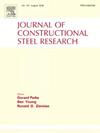脉冲电流GTAW Inconel 625/AISI 304 L钢异种接头:组织与力学性能
IF 4
2区 工程技术
Q1 CONSTRUCTION & BUILDING TECHNOLOGY
引用次数: 0
摘要
本研究旨在研究Inconel 625与AISI 304 L钢脉冲电流气体钨极弧焊(PCGTAW)异种接头的组织和力学行为。采用镍基ERNiCrMo-3钎料制备了异种金属焊接(DMW)接头。利用光学显微镜、扫描电镜(SEM)和x射线能谱仪(EDS)对焊接接头进行了显微组织研究。机械特性包括在室温和高温下测量显微硬度、夏比冲击韧性和拉伸性能。显微组织表征表明,焊缝金属呈现出良好的等轴枝晶结构,从顶部到根部(从顶部到根部孔道)变化明显。这种变化归因于连续道次的加热效应和从顶部到根部冷却速率的差异。电子探针显微分析仪(EPMA)和SEM-EDS分析表明,焊缝金属的奥氏体基体中存在富Ti和Nb的NbC/TiC相和富Nb和mo的Laves相。此外,还证实了Mo、Cr和fe丰富的M23C6碳化物的存在。对界面的光学和扫描电镜观察发现,AISI 304 L钢与ERNiCrMo-3钎料的界面附近存在宏观偏析,表现为钎料缺陷区(未混合区、半岛区和岛状区)。线形图和EPMA分析证实焊缝金属与AISI 304 L钢的界面上存在明显的成分梯度和元素扩散。对于半岛和岛屿,EDS线/区域元素;图和EPMA图显示Fe和Cr为主导元素,表明这些区域的成分介于焊缝金属和AISI 304 L母材之间,与AISI 304 L母材的成分非常接近。脉冲电流使其形成细小的等轴结构,次级相颗粒均匀分布,对其力学性能有积极影响。焊缝金属的夏比冲击韧性和硬度分别为152±4 J和232±6 HV。在室温和高温下,来自AISI 304 L母材而不是焊接金属的拉伸试验试样的失效表明其适合最终应用。室温平均抗拉强度为668 MPa。在高温下,拉伸强度在550℃时为370 MPa, 600℃时为368 MPa, 650℃时为311 MPa。本文章由计算机程序翻译,如有差异,请以英文原文为准。
Pulsed current GTAW Inconel 625/AISI 304 L steel dissimilar joint: Microstructure and mechanical properties
The present study aims to investigate the microstructure and mechanical behavior of Pulsed Current Gas Tungsten Arc Welded (PCGTAW) dissimilar joints of Inconel 625 and AISI 304 L steel. The dissimilar metal welded (DMW) joint was obtained using the Ni-based ERNiCrMo-3 filler. The welded joint was subjected to a microstructural study using optical microscopy and Scanning electron microscopy (SEM) with energy dispersive X-Ray spectroscopy (EDS). Mechanical characterization involved measuring microhardness, Charpy impact toughness, and tensile properties at both room temperature and high temperatures. Microstructural characterization revealed that the weld metal exhibits a fine equiaxed dendritic structure, which varies from the top to the root region (from the capping to the root pass). This variation is attributed to the heating effect of successive passes and the difference in cooling rates from the top to the root region. The electron probe micro-analyzer (EPMA) mapping and SEM-EDS analysis revealed the presence of Ti and Nb-rich NbC/TiC phases and Nb and Mo-rich Laves phases in the austenitic matrix of the weld metal. Additionally, the presence of Mo, Cr, and Fe-rich M23C6 carbides was also confirmed. Optical and SEM observations of the interface revealed the macrosegregation near the interface of AISI 304 L steel and ERNiCrMo-3 filler weld metal, characterized by filler-deficient zones (unmixed zone, peninsula, and island). Line mapping and EPMA analysis confirmed a sharp compositional gradient and elemental diffusion across the interface of weld metal and AISI 304 L steel. For the peninsula and island, EDS line/area elemental; mapping and EPMA mapping showed Fe and Cr as the predominant elements, indicating that the composition in these areas is intermediate between the weld metal and AISI 304 L base metal, closely resembling the composition of the AISI 304 L base metal. The pulsed current resulted in the development of a fine equiaxed structure, with a uniform distribution of small secondary phase particles, which has positively influenced the mechanical properties. The Charpy impact toughness and hardness of the weld metal were 152 ± 4 J and 232 ± 6 HV, respectively. The failure of the tensile-tested specimens from the AISI 304 L base metal rather than the weld metal, at both room and high temperatures, indicates its suitability for the end application. The average tensile strength at room temperature was 668 MPa. At elevated temperatures, the tensile strengths were 370 MPa at 550 °C, 368 MPa at 600 °C, and 311 MPa at 650 °C.
求助全文
通过发布文献求助,成功后即可免费获取论文全文。
去求助
来源期刊

Journal of Constructional Steel Research
工程技术-工程:土木
CiteScore
7.90
自引率
19.50%
发文量
550
审稿时长
46 days
期刊介绍:
The Journal of Constructional Steel Research provides an international forum for the presentation and discussion of the latest developments in structural steel research and their applications. It is aimed not only at researchers but also at those likely to be most affected by research results, i.e. designers and fabricators. Original papers of a high standard dealing with all aspects of steel research including theoretical and experimental research on elements, assemblages, connection and material properties are considered for publication.
 求助内容:
求助内容: 应助结果提醒方式:
应助结果提醒方式:


